IBPA Independent caught up with New York City-based Heliotrope Books (heliotropebooks.com) to discuss the publisher’s creation, niche, and sales and distribution strategy.
Tell me a bit about the creation of Heliotrope Books.
The seeds of Heliotrope Books were planted when I was 5 years old and my kind, patient mother typed up my rambling stories on the old Remington. We would cut bits of type into strips and paste them into books that I illustrated with crayon. Twenty years later, in the 1980s, I illustrated books and cut and pasted type for a living. I worked for large presses, like Random House and Scholastic, and smaller ones like Writers and Readers Inc. In the 1990s, I was cutting and pasting on a computer screen for book and magazine publishers in New York City.
I had the skill set to start my own press for years before I did. In 2006, I found myself on a tour of a Brazilian rainforest. One of the other participants knew the medicinal and nutritional properties of any herb or flower she saw, and spoke about them as if she were describing old friends.
“Have you ever written about plants?” I asked Leda Meredith.
“I’ve been trying to get published for years,” she told me.
Back in New York, I helped her pitch a memoir about local food and foraging. Every big press turned her down, claiming that the market for such locavore books was “saturated.”
“Then I’ll publish it,” I told her. “Your voice is unique and wonderful, even within this burgeoning genre.”
In 2008, I released Leda’s debut memoir—Botany, Ballet, and Dinner from Scratch—and Heliotrope Books was born.
By 2022, Leda Meredith has published books about foraging and food preservation with four other presses: Globe Pequot, Timber Press, Countryman Press, and W.W. Norton. Her initial publication with Heliotrope was a stepping-stone to a broader platform.
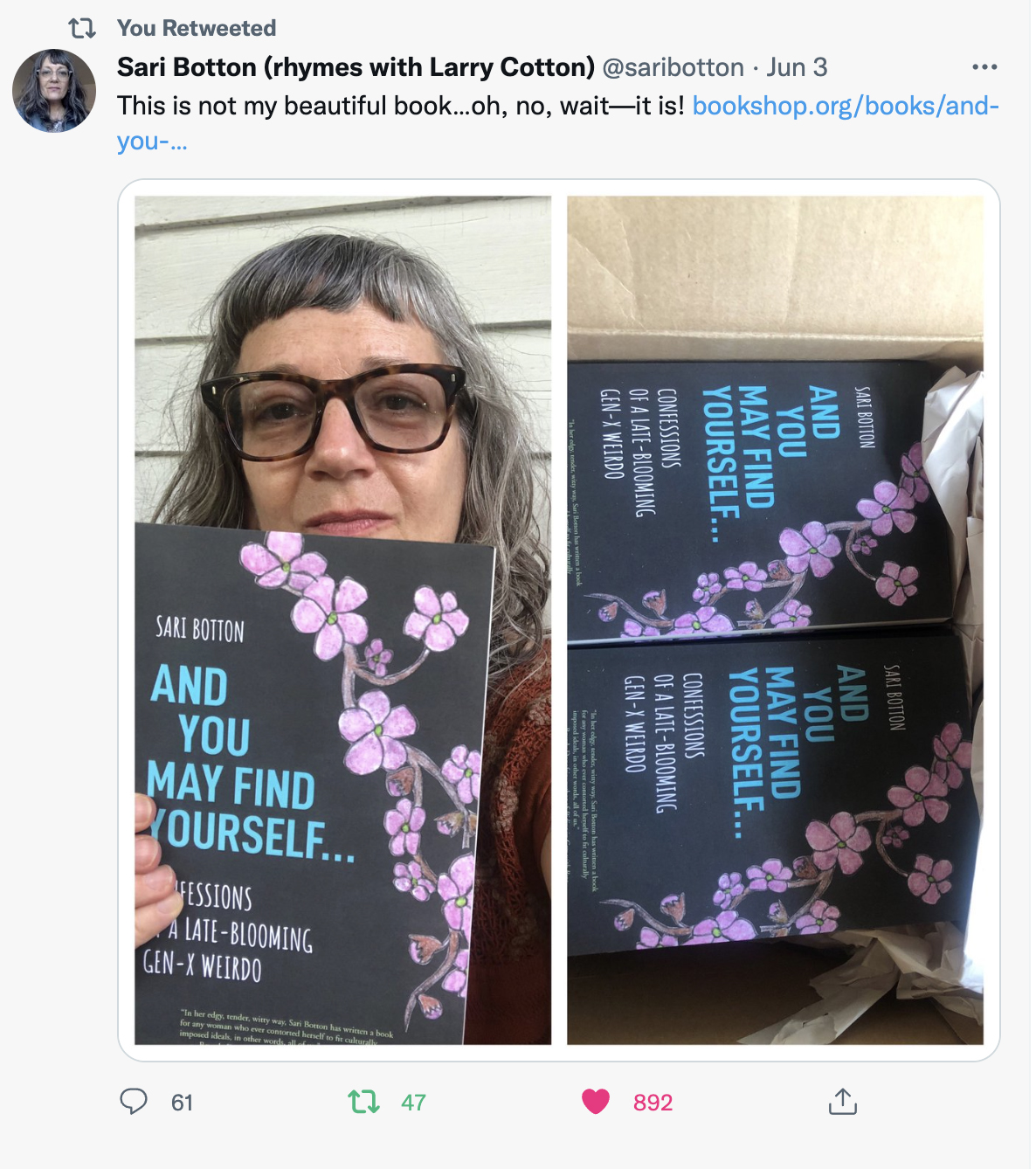
Sari Botton shares her stunned disorientation and delight on Twitter, when boxes of her memoir are delivered to her in June 2022. At her request, the book cover was designed.
Who makes up your team?
When Heliotrope was launched, I had a business partner. While he was quite helpful, he lost patience with the slow arc of success in book publishing and bowed out after three years. I have been a sole proprietor since 2010.
As publisher, I am the hub of a wheel with many spokes—including designers, copy editors, IP attorneys, an accountant and database specialist, a web host, an in-house publicist, and a printer/distributor with a sales consultant.
My mother, now 92, helps me review manuscripts for acquisition, and has been an invaluable editor. I also share potential acquisitions with younger people, in their 20s and 30s, to solicit their feedback. I like to see that a manuscript resonates for readers of different ages.
On board with me as well are, of course, the authors and their teams of literary agents, dedicated book publicists, and social media specialists. Often, successful publications arise from such creative collaboration between experts about sales and distribution strategy.
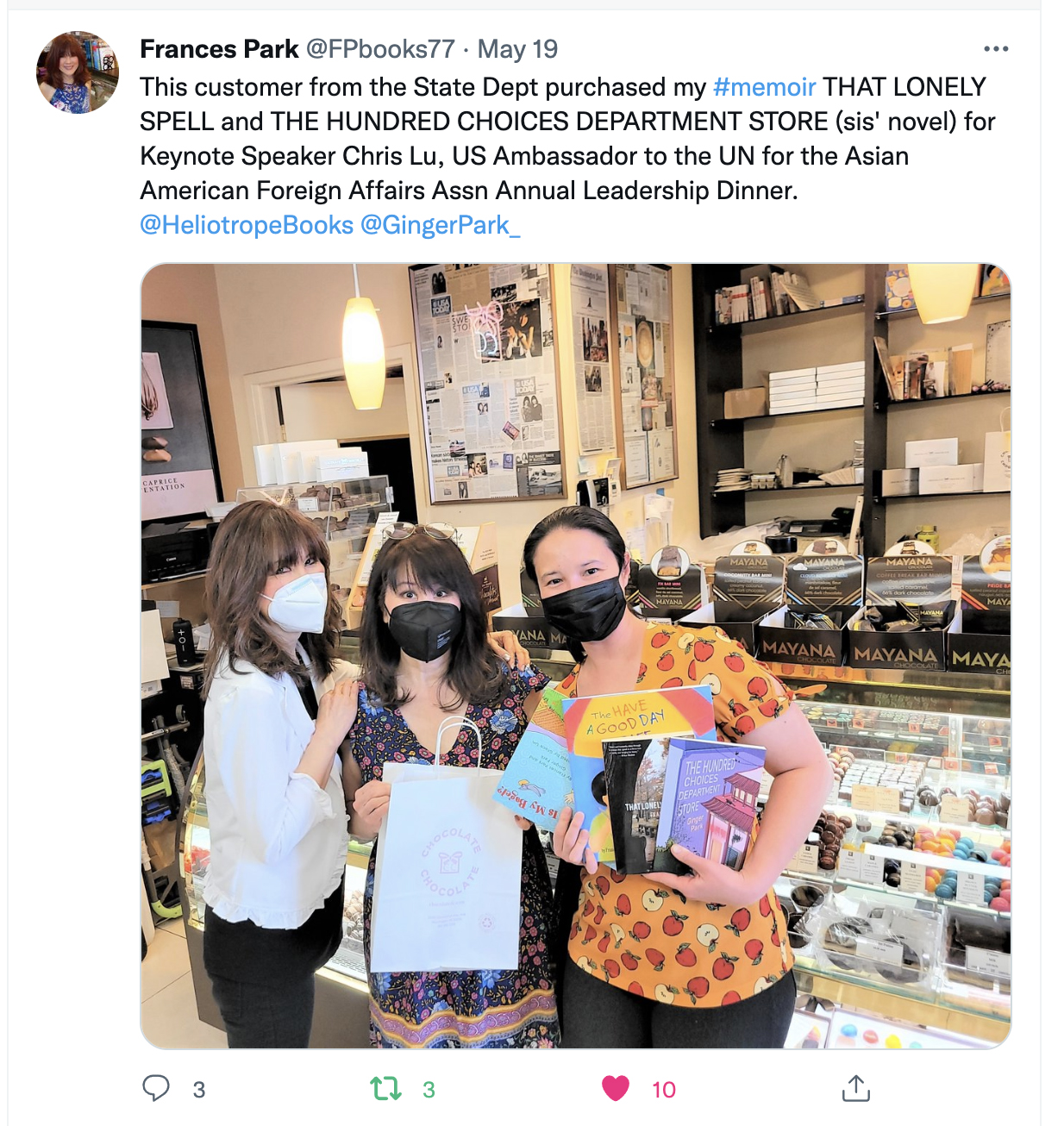
Frances Park and her sister, Ginger Park, sell books to distinguished patrons of Chocolate Chocolate, their specialty shop in Washington, D.C.
Talk to me about how you found your publishing niche and why you think it’s important.
An indie press serves the same important purpose as an indie film company or record label: We amplify new voices and meaningful material, so the arts do not become a matter of exclusive membership, repetition, or sheer celebrity.
As we say on our website: “Heliotrope Books is a conduit for emerging voices and for seasoned authors who have taken risks with new materials. An indie press based in Lower Manhattan, Heliotrope aims to publish the smartest, tastiest under-the-radar titles out there—those that encompass more than one sales category (such as ‘literary and commercial,’ or ‘memoir and cookbook’), valuable books that might otherwise fall through the cracks of traditional publishing.”
Numerous promising books are declined by the big houses, as Leda’s was. And like Leda’s, they are written by gifted, passionate, informed authors with a community and natural readership. Big presses must prioritize big names with big sales potential—as they pay big salaries and overhead. As an indie press that functions from a home office in my apartment, I am positioned to take calculated risks that they assess they cannot.
Heliotrope is probably best known for our memoirs, including the “memoir noir” or “mem-noir” category we coined to describe those gothic “truth is stranger than fiction” accounts for which readers have an undying appetite. In 2020, Wiki.ezvid.com identified Heliotrope as one of five “Companies that Publish Great Memoirs.”
In addition to memoir, our list includes debut and experimental fiction, cookbooks, and a literary biography and business book or two.
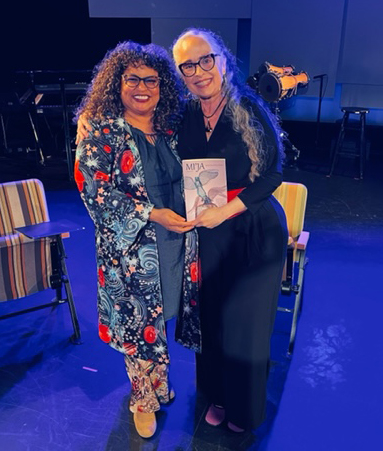
Magdalena Gómez with Rhina Valentín at Pregones Theater in the Bronx, where she launched her memoir in May 2022. Photo by George Malave.
How do you find and attract authors to publish with Heliotrope?
There are two major ways in which authors come to publish with Heliotrope: 1) I know the author and a book idea blossoms organically out of our acquaintance; or 2) the book is pitched to me, sometimes by a literary agent or an author.
The three main traits I seek in an author are talent, honesty, and determination—because it takes all three to undergo the heavy lifting of publishing and promoting a book. Basic sanity is also a boon because aspects of the publication process rattle even the steadiest nerves.
Heliotrope is a regional press, to some extent. Some 80% of our authors live in or write about New York City and the tri-state area. We do not exclusively publish New York-based or urban authors and content, but locale is often natural touchstone for a small press.
I’ve known some of my authors “forever.” My sister, musician and songwriter Leah Wells, wrote On Another Note (2016), a memoir about teaching music and movement in a Head Start program in the Bronx. We included songs and classroom exercises that I illustrated. (leahwellsmusic.com/publications)
My friend from fifth grade, singer/songwriter Whit Hill, had been Madonna’s roommate and “bestie” as an undergraduate in Ann Arbor. Her Not About Madonna (2011) has earned its rank among books about Madonna and is a delightful read. (whithill.com/not-about-madonna)
I met poet laureate and playwright Magdalena Gómez in the East Village when I was an undergrad. In May 2022, Heliotrope published her memoir, Mi’ja. (mijamemoir.com)
Renowned New York City professors Susan Shapiro and Sonia Pilcer have been my writing teachers. It was my honor to publish each of their recent novels.
I have yet to meet many authors in person—even though I feel close to them, having edited and designed their highly personal books.
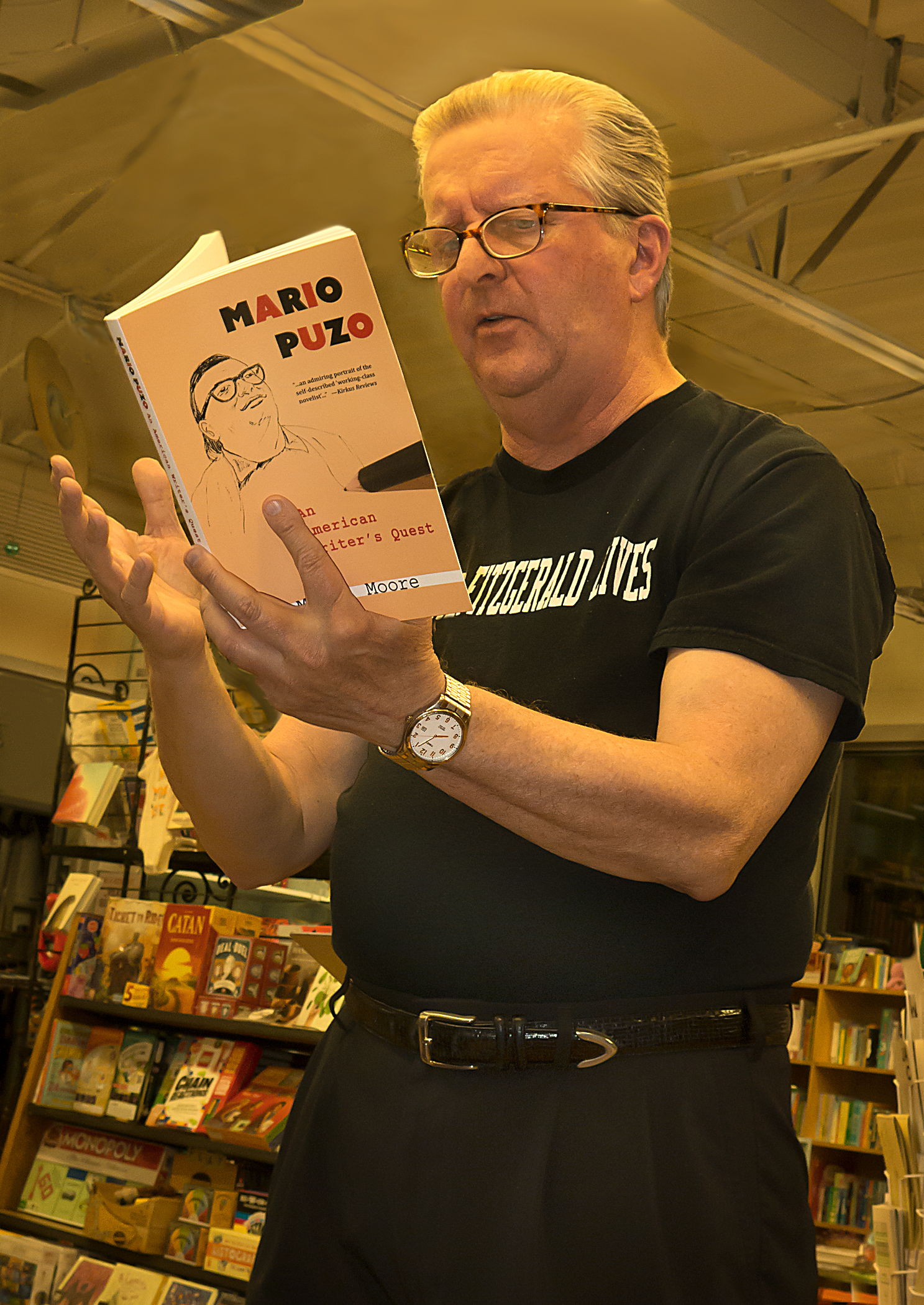
M. J. Moore reads from his literary biography of Mario Puzo at Book Culture in Manhattan, 2019. Photo by Judy Rosenblatt.
What is Heliotrope’s sales strategy? Do you go direct to consumer, sell in bookstores, release e-books and audiobooks, etc.?
Online retail carries the day: Because we are a micro press that publishes fewer than 20 titles a year, Heliotrope does not have a sales force that approaches book buyers in stores and libraries. That onus is on our shoulders, and there is no guarantee that any book will obtain commercial shelf space. Therefore, we rely upon online retail to sustain sales after the launch window (six to eight months after publication) closes.
Our sales strategy is “long-haul,” because books remain relevant long after their launch. For us, strong sales derive from our authors’ engagement with their natural communities over time. Some authors share their mission in person—in a classroom, lecture hall, or theater—while others work primarily online, through social media, podcasts, and videos. On occasion, our authors have been interviewed on TV. Essentially, an author’s passion and presence sell a book.
Authors and publishers may dream of meteoric bestsellers, but “book buzz” can take years to develop. For example, Sari Botton writes: “Before publishing my memoir, And You May Find Yourself...Confessions of a Late-Blooming Gen-X Weirdo with Heliotrope, I had already learned through the anthologies I edited that a book's success is built over time. Goodbye to All That: Writers on Loving & Leaving NY was originally published in 2013, and Never Can Say Goodbye: Writers on Their Unshakable Love for New York was published in 2014, and both became only more popular with exposure. I worked hard to keep promoting them, and it paid off. In the case of Goodbye to All That, the book gained so much traction over the years that, in 2019, Seal Press asked me to update it with seven new essays. It was reissued in April 2021 and just keeps selling.”
We encourage a “slow time release launch” that, ideally, includes author appearances (live and virtual), serial excerpts in media, reviews and interviews, and an ongoing social media campaign. This varied approach reaches different audiences, and responds flexibly to cultural or topical events.
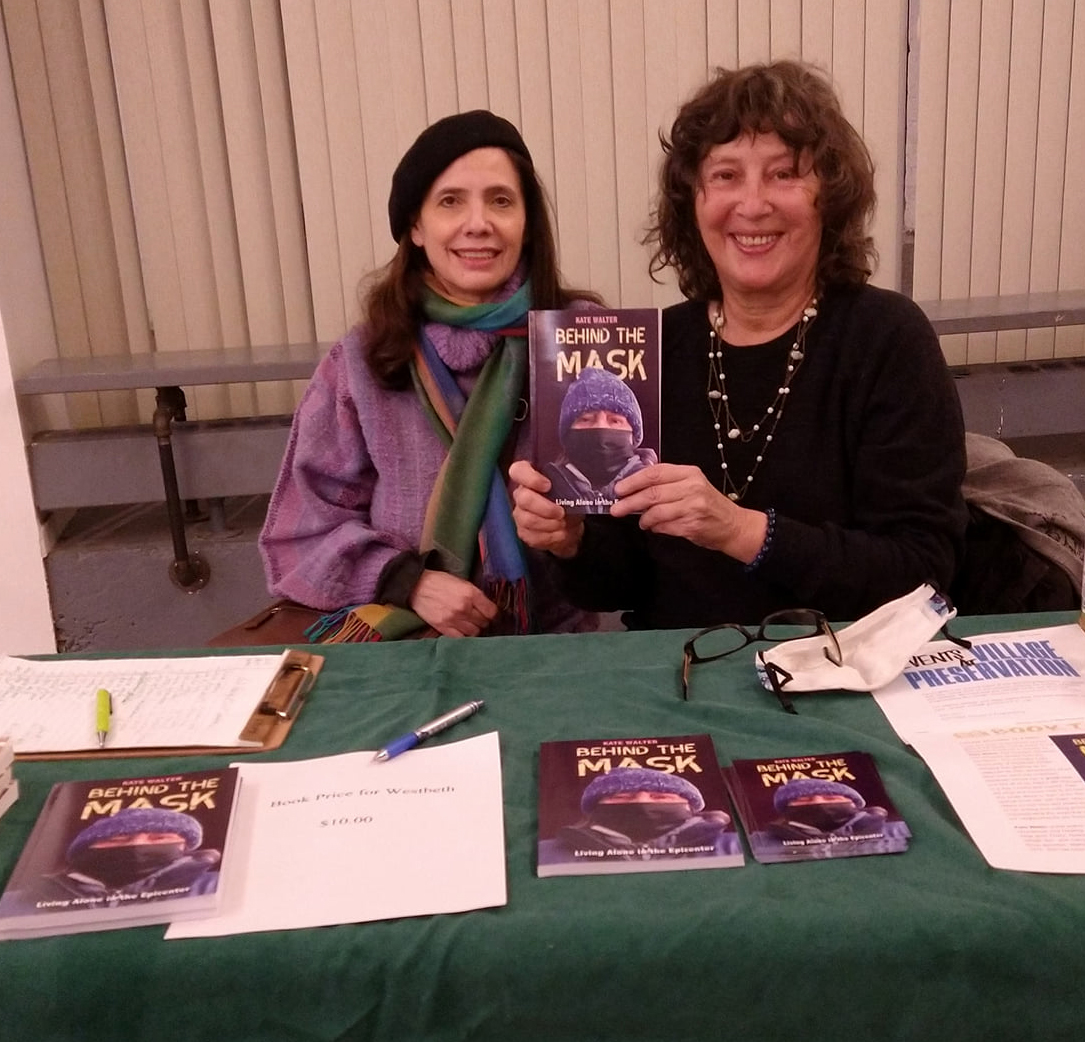
Heliotrope Publisher Naomi Rosenblatt at a book signing with author Kate Walter in Westbeth Artists Housing in Manhattan, 2021. Photo by Jen Maguire.
Direct-to-consumer: This has worked for us in a targeted, customized way. Two examples come to mind: fiction author Seth Kanor—a bartender when his novel, Indian Leap, was released in 2015—collected email addresses of customers that took an interest in his writing. Hundreds of books sold that way. In 2022, Tablet magazine conducted an email blast to publicize The End of Her, a true crime memoir by its distinguished executive editor Wayne Hoffman. Hundreds of books sold each day after that email campaign was initiated. I do not believe these authors would have enjoyed the same degree of success had we done more “generic blasts” to random email lists. Readers clearly recognized the authors’ names and were eager to buy their books.
Sometimes, direct-to-consumer sales happen on the spot. For example, Frances Park, author of That Lonely Spell, and her sister Ginger Park, who is also a published author, co-own a chocolate shop in Washington, D.C., where they each sell their books as well as scrumptious offerings of gift chocolates. In this natural circumstance, book sales grow out of chats with their customers, as Seth Kanor’s did. Novelist Christie Grotheim and her husband have opened an inn for writers seeking a rural retreat outside of Nashville, Tennessee. Christie continually sells her 2019 novel, The Year Marjorie Moore Learned to Live, to her guests.
Finally, a direct-to-consumer appeal can be made through social media programs. Alice Carbone Tench’s series of cooking videos, Instagram to Table, inspired her cookbook memoir Eating Again. Alice’s regular Instagram and YouTube viewers requested that she write a book that included her plant-based recipes from Italy, and short essays about how this food helped her overcome eating disorders. During lockdown in 2020, Magdalena Gómez created a daily podcast of poetry, music, and performance called Jazz Ready. Now her international audience is aware of her debut memoir, Mi’ja.
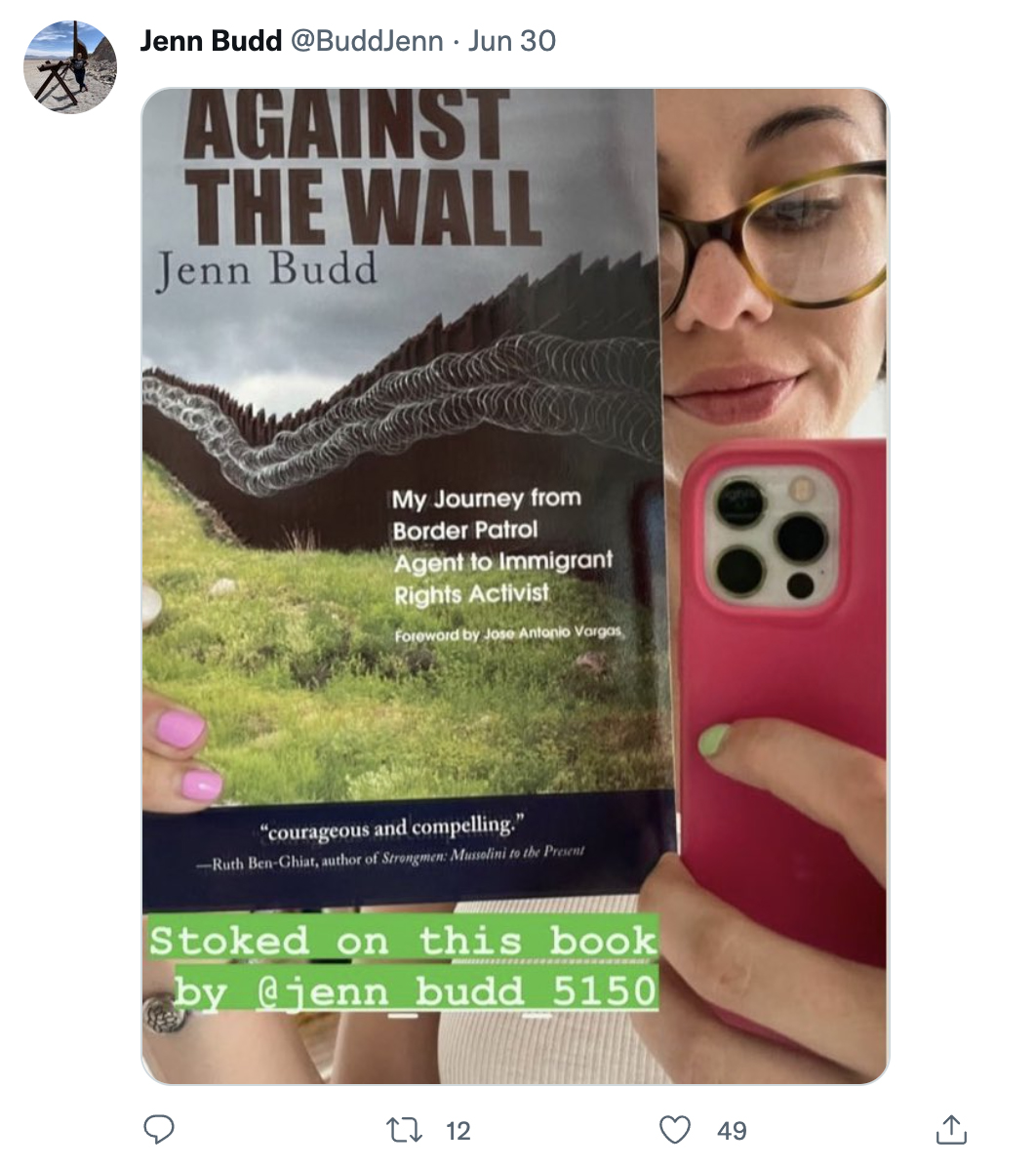
Jenn Budd continually promotes her June 2022 title on Twitter.
Bookstores: Many authors dream of seeing their titles displayed in their favorite bookshop. While that sometimes happens, fewer stores and more publications make shelf space more competitive than it has ever been. Once a book claims space in a brick-and-mortar store, it must meet a sales quota to remain there. Libraries, too, must record a certain number of loans each year to justify keeping a book in their inventories.
I advise my authors to imagine acquisition through the viewpoint of the book buyer: They are inundated with pitches from presses that have a sales force and must decline many of those books. Why would a title from a smaller press tempt them? I’ve learned there are three motivators: a launch event scheduled with a live author reading and book signing; extensive regional press coverage of the book; and multiple requests for the book from customers.
For example, in 2019 Barbara Roberts’s memoir The Doctor Broad was reviewed widely in Rhode Island newspapers, as Roberts had served as cardiologist to the state’s mafia dons in the 1980s and she had local tales to tell. Before publication, numerous Barnes & Noble branches and indie bookstores in Rhode Island contacted Heliotrope, expecting demand for the book.
In June 2022, author Sari Botton posted this request to her extensive Twitter following: “I’d love it if you’d ask your local indie bookseller to stock my book … Since it’s published by Heliotrope Books, a small indie press, it doesn’t automatically get broad distribution like books published through big, mainstream presses. Thank you.” Her straightforward request has inspired orders from booksellers throughout the country.
Do you have a distributor? Talk to me about your distribution strategy.
In 2021, Heliotrope Books was accepted into an incubation program for small presses called Ingram Ignite. We had been an Ingram Lightning Source customer for over 10 years, and had come to rely upon print-on-demand technology to generate our paperbacks and hardcovers. Larger presses also use print-on-demand for books whose sales projections are uncertain. POD enables publishers to submit an executable file that will print, on demand, any particular number of books that is ordered at a given time—rather than produce, for example, 2,000 or 10,000 at once—500 of which may sell. The publisher would then pay to warehouse those extra books for years.
Not only does print-on-demand alleviate the need for costly offset print runs and warehousing, but our Ingram program also enables distribution over online channels throughout the world. Amazon, Barnes & Noble, IndieBound, and Bookshop, for example, are Ingram’s distribution partners. Ingram Lightning Source truly made a press like Heliotrope Books possible.
We hold a separate account with Amazon exclusively for our Kindle editions. Through Ingram Ignite, we distribute e-books over other popular platforms like Nook, Kobo, Apple, iTunes, and library-specific formats.
In July, we released our first audiobook with an audiobook distributor. Therefore, it is fair to say that we have three separate distributors for our different types of books—though Ingram remains home base for distribution.
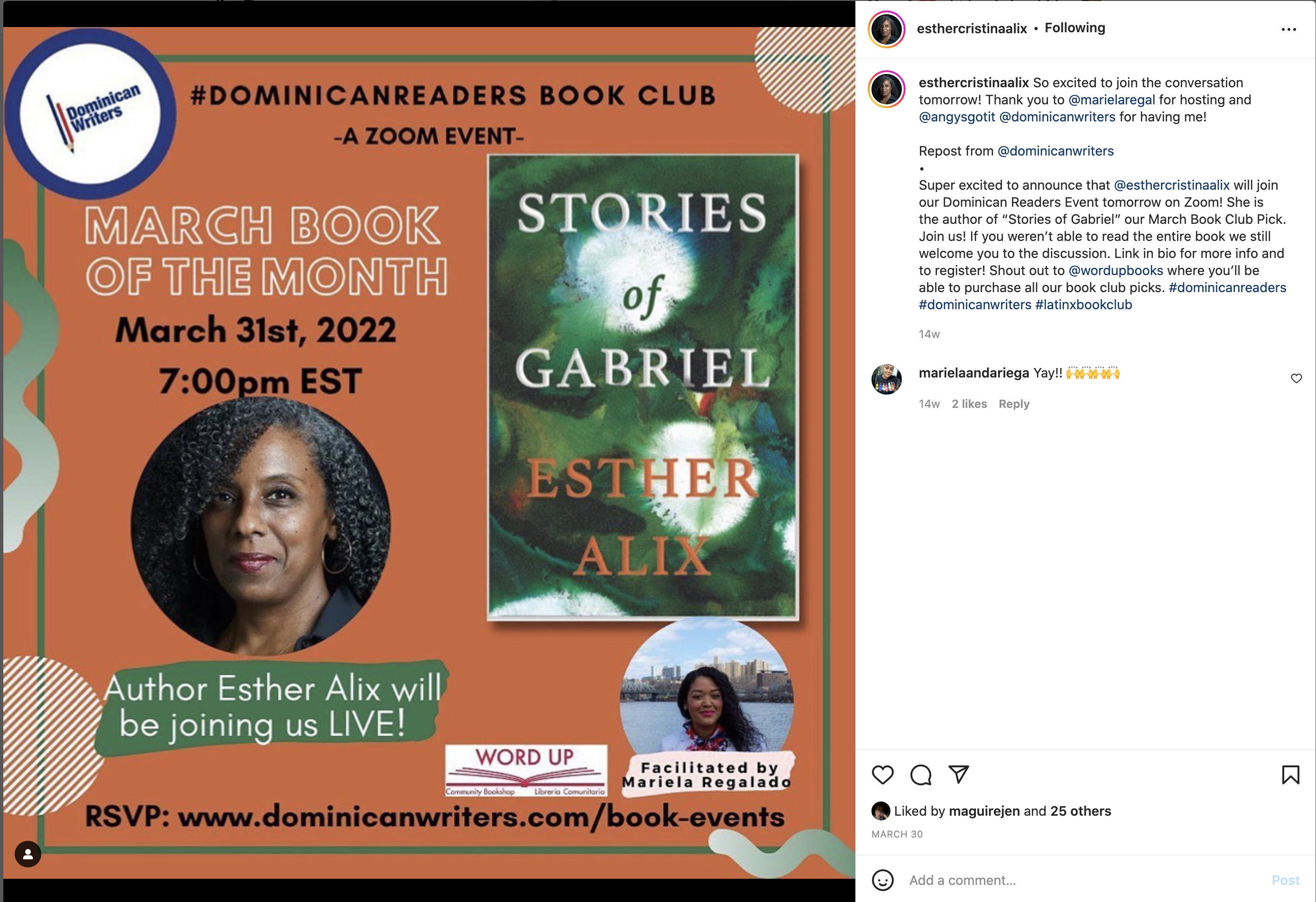
Esther Alix creates an extensive Instagram campaign when COVID-19 necessitates virtual events for her February 2022 launch.
What does success look like for Heliotrope Books?
We put something out into the world because we believe in it, and it comes back to us in the form of recognition, opportunities, and sales. Of course, volume sales are the metric that come to mind when gauging success. They do tend to be few and far between, geysering around book launches and as a result of far-reaching publicity events like author appearances on TV or radio.
Beyond these short-lived but vital upsurges in sales, I feel gratified when our books receive good reviews in trade publications. We have done well with Kirkus, which has appraised many of our books with enthusiasm. This year, we received three reviews in Publisher’s Weekly, two of them starred. When I read PW’s assessment of Alice Carbone Tench’s Eating Again as “a sincere and delicious chronicle … to savor” I felt overcome with warmth—since I, too, had felt that about her writing, which is why I devoted my time and resources to publishing it.
It is also a thrill when celebrities I admire endorse our books. I can never forget my joy when one of my favorite singer/songwriters, Lucinda Williams, wrote of Whit Hill’s Not About Madonna: “I was moved to tears.” Or when another great performer, Melissa Etheridge, wrote “You will be changed” about Tom Huth’s Forty Years Stoned. I feel proud that renowned author Ruth Ben-Ghiat described our June 2022 title Against the Wall by Jenn Budd as “courageous and compelling.” Other outstanding authors who have endorsed our books include Catherine Texier, Sara Benincasa, T. J. English, Beverly Donofrio, and Jonathan Ames.
Finally, it is always heart-stopping when I receive unsolicited requests for serial publication rights or review copies. Before Against the Wall was released, author Jenn Budd was approached by the Guardian, who did publish her first serial excerpt. Without saying too much prematurely, several other prominent publications have requested review copies of various titles for possible review or literary prizes.
In short, success for Heliotrope Books is confirmation, from respected others, that our books are well worth a reader’s time.

Alice Carbone Tench takes advantage of the outdoor farmer’s market in Los Angeles to promote and distribute her cookbook in February 2022.
Do you have any examples of successful, or even unexpected, sales results that you can share?
Two recent surprises:
1. The true crime genre has done outstandingly well with Heliotrope—The Doctor Broad has been a perennial seller since 2019, and this year’s The End of Her seems to be following in its footsteps.
2. A book about overcoming addiction, Stumbling Home, has outdone its projected sales numbers. I had hesitated to accept it for publication, suggesting to the author that “there are so many books about drinking and sobriety on the market.” She made her case: There is always a need for more. Recovering addicts need continual support and reinforcement of their efforts. I could not help but remember pitching Leda’s book 10 years earlier and hearing the same words from prospective publishers about a “saturated market.” Now that I was on the other end of that conversation. Could I make a difference?
True to her word, author Carol Weis has continued to promote her book in tandem with events that highlight recovery from addiction—like Alcohol Awareness Month in April. She writes, “Even though most of my promotion's been done on social media, I think my face appearing on the cover of a local magazine during National Recovery Month (including a feature article from a phone interview) contributed to a good spike in sales. And being invited as a contributor to the addiction platform, All Sober, has also helped sales.”
Perhaps Stumbling Home’s success should not have surprised me. Catherine Hiller’s Just Say Yes, about managing her cannabis habit, has also been a steady seller over the years—especially after it was written up twice in The New York Times within a month of its publication. I was warned by naysayers around me not to publish anything about marijuana, (both Hiller’s and Huth’s books) or about the Moonie cult (Lisa Kohn’s To the Moon and Back), or U. S. Border Patrol (Jenn Budd’s Against the Wall).
Yet, the risks have proven to be worth it. Nonfiction about crime and addiction sells. Who knew?
Learn more about this topic: